This post may contain affiliate links. Please read our
disclosure policy
for more information.
As someone who hails from a Chinese background, a culture brimming with superstitions and specific dos and don’ts for Chinese New Year, I’ve always been fascinated by the concept of good luck foods.
In our tradition, certain dishes are believed to bring prosperity, longevity, and even a salary bump (yes, please!). If you’re curious, check out my deep dives into Chinese New Year foods and what to eat for a prosperous year.
But the intrigue doesn’t stop there; the whole world has its array of culinary traditions to ring in the New Year. From Spain’s grape countdown to Japan’s hopeful slurp of soba noodles, every bite is steeped in meaning and a wish for the coming year.
So, join me as we embark on a delicious journey around the globe to explore the fascinating and sometimes quirky world of good luck foods for New Year’s. Let’s eat our way to luck and fortune, one tradition at a time!
Spain: Las Doce Uvas de la Suerte (12 Lucky Grapes)
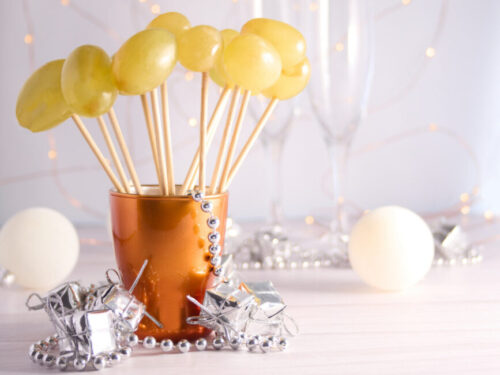
In Spain, the stroke of midnight on New Year’s Eve, or Nochevieja, is marked not just by celebration but by a deliciously quirky tradition known as “las doce uvas de la suerte,” or the “twelve lucky grapes.” As the historic clock tower at Puerta del Sol chimes its way into the new year, Spaniards partake in a challenge: to eat one grape for each of the twelve chimes. The goal? To finish all your grapes before the last chime fades – a task that’s trickier than it sounds!
This custom, dating back to the 1880s, echoes the French tradition of enjoying grapes and champagne but with a twist. Initially, Madrid’s bourgeoisie savored this ritual, but soon, the masses adopted it in a playful jest, gathering in public squares to partake.
From its satirical origins, the ritual has blossomed into a widespread practice, symbolizing hope and good luck for each month of the new year. And though it started in Spain, it has since found its way across the seas, becoming a cherished part of New Year’s Eve in various countries across Latin America.
Southern United States: Hoppin’ John
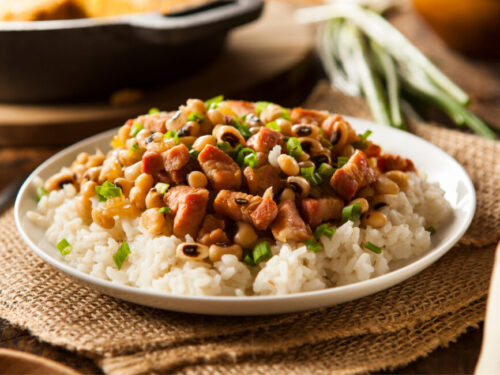
Down South, when the New Year rolls around, eating black-eyed peas, particularly in a dish known as Hoppin’ John, is an act steeped in history and symbolism.
They say during the Civil War, these peas were often what folks had to make do with – and now, eating them is like a little nod to getting through tough times. When you cook them, they puff up a bit, which people like to think of as a sign of growing prosperity. Often served with greens (representing money) and cornbread (symbolizing gold), this meal is a hopeful nod to a prosperous year ahead. It’s a comforting Southern tradition that’s all about resilience and looking ahead, with a side of deliciousness.
Japan: Soba Noodles
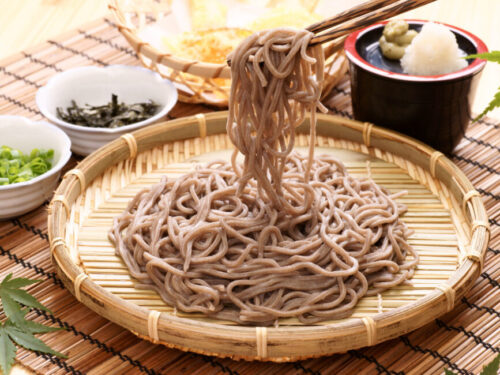
Japan’s New Year’s Eve, or Ōmisoka, brings a special noodle to the table – Toshikoshi soba. These buckwheat noodles, known for their length and resilience, symbolize the wish for a long and healthy life.
The tradition dates back to the Edo period and embodies more than just longevity; it’s about cutting away the old year’s regrets and starting anew. Soba’s ease of cutting while eating reflects the hope of breaking away from the hardships of the past year.
As families gather around steaming bowls of these noodles, there’s a quiet reflection on the year that has passed and a look forward to the journey ahead. Each slurp is not just a taste of tradition but a mouthful of hope and renewal. 🍜
The Netherlands: Oliebollen
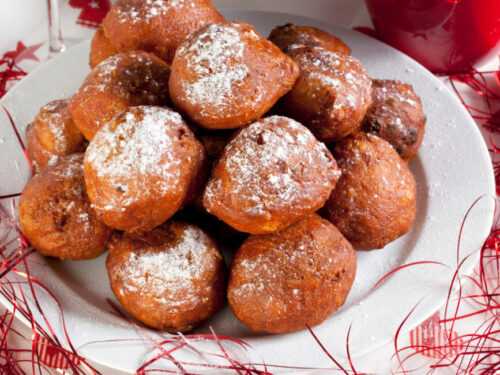
In the Netherlands, when New Year’s Eve comes around, you’ll find everyone munching on Oliebollen. These aren’t just your average doughnuts; they’re like little balls of magic. Packed with fruit and dusted with powdered sugar, they’re said to have a pretty cool superpower: warding off evil spirits.
The tradition has its roots in Germanic mythology, where the goddess Perchta would try to slice open the bellies of those she came across, but the fat from the oliebollen would make her sword slide off! So, eating them is not just tasty, it’s practically a protective charm for the new year. I mean, if eating doughnuts keeps away evil, count me in!
Italy: Cotechino con Lenticchie

As the clock strikes midnight in Italy, there’s one dish you’ll find on many tables: Cotechino con Lenticchie. This dish, with its hearty pork sausage sitting atop a bed of lentils, isn’t just delicious – it’s a symbol of good luck and prosperity. The lentils, with their coin-like shape, represent wealth, and the rich, flavorful sausage symbolizes life’s bounties.
It’s a New Year’s tradition from the Emilian-Romagna region of Italy that goes back centuries, offering a promise of good fortune and deliciousness in every bite. One of the best ways to eat your way to a prosperous new year is with this Italian classic.
France: Galette des Rois
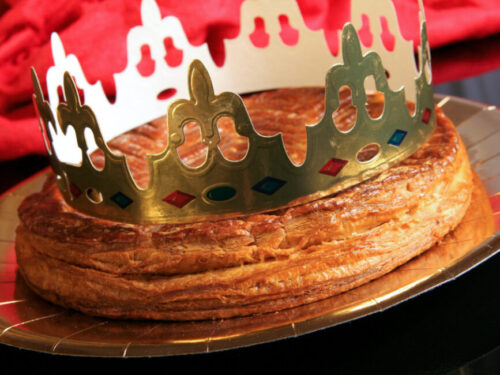
In France, the end of the Twelve Days of Christmas ushers in the Epiphany, also known as the “Fêtes des rois” or Three Kings Day – a holiday commemorating the day the three wise men first laid eyes on baby Jesus and presented their gifts. It’s a day steeped in tradition and celebration, and the star of the show? “La Galette des Rois,” or King’s Cake.
This isn’t just any cake; it’s a flaky, buttery delight filled with rich frangipane. Hidden within its layers is a tiny figurine, or fève, and finding it means you’re king or queen for the day, blessed with luck and prosperity. This dessert isn’t just a treat for the taste buds; it’s a nod to a momentous occasion in history, marking the start of the Carnaval season.
South Korea: Tteokguk
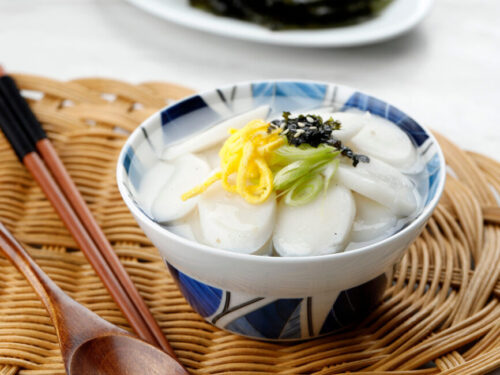
In South Korea, there’s a deliciously cozy way to ring in the New Year: by savoring a bowl of Tteokguk.
This warm, comforting bowl of soup filled with sliced rice cakes, symbolizes a fresh start and, interestingly enough, getting a year older. Yep, in South Korea, age is counted from the first day of the lunar year, so you’re not officially a year older until you’ve had your Tteokguk! It’s like a birthday and New Year’s rolled into one steaming bowl.
And during the Lunar New Year, families perform ancestral rites by serving tteokguk to their ancestors while eating together. So as you sip this soup, you’re not just enjoying a tasty tradition; you’re stepping into a new year and a new you. Pretty cool, right?
Greece: Vasilopita
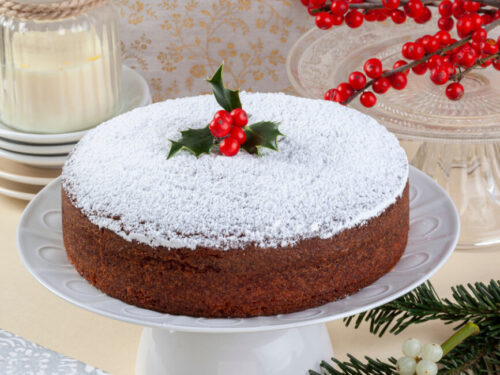
In Greece, the New Year brings with it a special cake known as Vasilopita, which means “Basil’s Bread”, after Basil the Great, archbishop of Caesarea in Cappodocia (Modern Turkey).
As the legend goes, during a time of famine, the emperor of Caesarea imposed a heavy tax upon its people. It was St. Basil who confronted the emperor, demanding he repent and do right by the town. The emperor did just that, cancelling the tax and turning over all of the coins and jewelry which had been paid as taxes by the people of Caesarea to St. Basil. In an attempt to reunite each taxation with its rightful owner, it is said that Basil baked the goods into a huge pita and called all of the townspeople to the cathedral. After Divine Liturgy, he blessed and cut the Vasilopita, serving a slice to each person, which miraculously contained their given valuables.
Inspired by this story, the modern Vasilopita is baked with a coin hidden in its sweet, bread-like layers. Finding it is said to bring you a year’s worth of good luck. Families gather around, each member eagerly awaiting their slice, hoping to be the lucky coin finder. It’s a sweet way to start the year, filled with anticipation and a bit of friendly competition. And if you’re the lucky one, hey, your year’s off to a pretty solid start!
Norway and Denmark: Kransekage
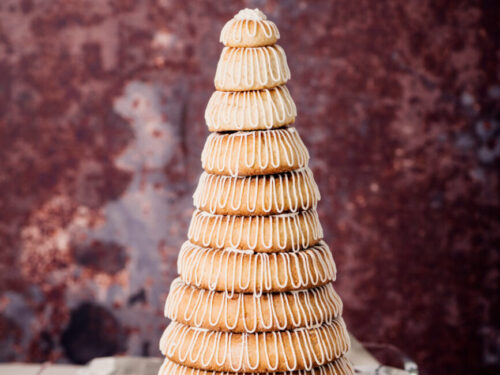
In Norway and Denmark, when it comes to New Year’s celebrations, they have a towering tradition: the Kransekage. This is one special cake: a stunning, cone-shaped masterpiece made of rings, often decorated with flags and fireworks. It’s said to bring good fortune, and let’s be honest, it’s also a showstopper at any New Year’s Eve party.
Biting into its chewy, marzipan-like layers, you’re not just savoring a sweet treat; you’re taking part in a tradition that’s as much about hopes and dreams as it is about flavor.
Philippines: 12 Round Fruits, Pancit & Rice Cakes
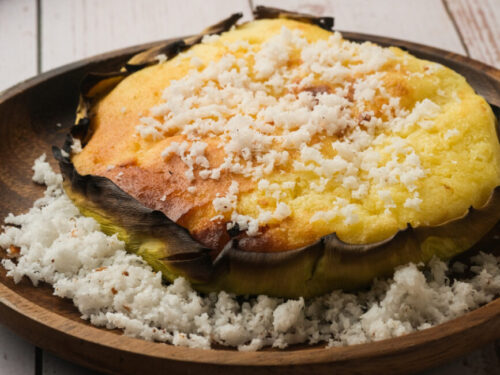
In the Philippines, New Year’s Eve isn’t just a celebration; it’s a feast of traditions, each with its own delicious significance. As the clock ticks towards midnight, Filipino families gather for ‘medianoche,’ a special meal that’s as much about flavor as it is about ushering in good luck for the upcoming year. The star of this feast? A platter of twelve round fruits, one for each month of the year. The round shape of the fruits is a nod to coins, a symbol of prosperity and wealth. It’s like inviting good fortune to the table, one fruit at a time.
And the festive dining doesn’t stop with fruit. There’s Pancit, a noodle dish that’s not just yummy but also full of meaning – long noodles for long life and good health. And let’s not forget the sticky rice treats. From the sweet biko to the savory bibingka (pictured above), these sticky delights are all about keeping the family bond strong and unbreakable. It’s a sweet metaphor, really – the stickier the treat, the tighter the family ties.
A Culinary World Tour–No Passport Required!
From the grape-filled celebrations in Spain to the heartwarming medianoche feasts in the Philippines, each one of these New Year’s good luck foods is a testament to the rich tapestry of global cultures and the joy of welcoming a fresh start.
Whether you’re planning to try one of these traditions or just got a kick out of reading about them, I hope it’s added a dash of excitement to your New Year’s Eve food ideas. As we count down to the new year, let’s embrace these wonderful culinary customs that promise prosperity, health, and happiness.
Here’s to hoping your New Year’s celebration – whether it’s quiet, loud, or somewhere in between – is as flavorful and promising as these fantastic global traditions. Happy New Year, my foodie friends! May your 2023 be as hopeful and joy-filled as these delightful New Year’s customs from around our wonderful world. 🌍🎉🍲
This post may contain affiliate links. Please read our
disclosure policy
for more information.
This post may contain affiliate links. Please read our
disclosure policy
for more information.
As someone who hails from a Chinese background, a culture brimming with superstitions and specific dos and don’ts for Chinese New Year, I’ve always been fascinated by the concept of good luck foods.
In our tradition, certain dishes are believed to bring prosperity, longevity, and even a salary bump (yes, please!). If you’re curious, check out my deep dives into Chinese New Year foods and what to eat for a prosperous year.
But the intrigue doesn’t stop there; the whole world has its array of culinary traditions to ring in the New Year. From Spain’s grape countdown to Japan’s hopeful slurp of soba noodles, every bite is steeped in meaning and a wish for the coming year.
So, join me as we embark on a delicious journey around the globe to explore the fascinating and sometimes quirky world of good luck foods for New Year’s. Let’s eat our way to luck and fortune, one tradition at a time!
Spain: Las Doce Uvas de la Suerte (12 Lucky Grapes)

In Spain, the stroke of midnight on New Year’s Eve, or Nochevieja, is marked not just by celebration but by a deliciously quirky tradition known as “las doce uvas de la suerte,” or the “twelve lucky grapes.” As the historic clock tower at Puerta del Sol chimes its way into the new year, Spaniards partake in a challenge: to eat one grape for each of the twelve chimes. The goal? To finish all your grapes before the last chime fades – a task that’s trickier than it sounds!
This custom, dating back to the 1880s, echoes the French tradition of enjoying grapes and champagne but with a twist. Initially, Madrid’s bourgeoisie savored this ritual, but soon, the masses adopted it in a playful jest, gathering in public squares to partake.
From its satirical origins, the ritual has blossomed into a widespread practice, symbolizing hope and good luck for each month of the new year. And though it started in Spain, it has since found its way across the seas, becoming a cherished part of New Year’s Eve in various countries across Latin America.
Southern United States: Hoppin’ John

Down South, when the New Year rolls around, eating black-eyed peas, particularly in a dish known as Hoppin’ John, is an act steeped in history and symbolism.
They say during the Civil War, these peas were often what folks had to make do with – and now, eating them is like a little nod to getting through tough times. When you cook them, they puff up a bit, which people like to think of as a sign of growing prosperity. Often served with greens (representing money) and cornbread (symbolizing gold), this meal is a hopeful nod to a prosperous year ahead. It’s a comforting Southern tradition that’s all about resilience and looking ahead, with a side of deliciousness.
Japan: Soba Noodles

Japan’s New Year’s Eve, or Ōmisoka, brings a special noodle to the table – Toshikoshi soba. These buckwheat noodles, known for their length and resilience, symbolize the wish for a long and healthy life.
The tradition dates back to the Edo period and embodies more than just longevity; it’s about cutting away the old year’s regrets and starting anew. Soba’s ease of cutting while eating reflects the hope of breaking away from the hardships of the past year.
As families gather around steaming bowls of these noodles, there’s a quiet reflection on the year that has passed and a look forward to the journey ahead. Each slurp is not just a taste of tradition but a mouthful of hope and renewal. 🍜
The Netherlands: Oliebollen

In the Netherlands, when New Year’s Eve comes around, you’ll find everyone munching on Oliebollen. These aren’t just your average doughnuts; they’re like little balls of magic. Packed with fruit and dusted with powdered sugar, they’re said to have a pretty cool superpower: warding off evil spirits.
The tradition has its roots in Germanic mythology, where the goddess Perchta would try to slice open the bellies of those she came across, but the fat from the oliebollen would make her sword slide off! So, eating them is not just tasty, it’s practically a protective charm for the new year. I mean, if eating doughnuts keeps away evil, count me in!
Italy: Cotechino con Lenticchie

As the clock strikes midnight in Italy, there’s one dish you’ll find on many tables: Cotechino con Lenticchie. This dish, with its hearty pork sausage sitting atop a bed of lentils, isn’t just delicious – it’s a symbol of good luck and prosperity. The lentils, with their coin-like shape, represent wealth, and the rich, flavorful sausage symbolizes life’s bounties.
It’s a New Year’s tradition from the Emilian-Romagna region of Italy that goes back centuries, offering a promise of good fortune and deliciousness in every bite. One of the best ways to eat your way to a prosperous new year is with this Italian classic.
France: Galette des Rois

In France, the end of the Twelve Days of Christmas ushers in the Epiphany, also known as the “Fêtes des rois” or Three Kings Day – a holiday commemorating the day the three wise men first laid eyes on baby Jesus and presented their gifts. It’s a day steeped in tradition and celebration, and the star of the show? “La Galette des Rois,” or King’s Cake.
This isn’t just any cake; it’s a flaky, buttery delight filled with rich frangipane. Hidden within its layers is a tiny figurine, or fève, and finding it means you’re king or queen for the day, blessed with luck and prosperity. This dessert isn’t just a treat for the taste buds; it’s a nod to a momentous occasion in history, marking the start of the Carnaval season.
South Korea: Tteokguk

In South Korea, there’s a deliciously cozy way to ring in the New Year: by savoring a bowl of Tteokguk.
This warm, comforting bowl of soup filled with sliced rice cakes, symbolizes a fresh start and, interestingly enough, getting a year older. Yep, in South Korea, age is counted from the first day of the lunar year, so you’re not officially a year older until you’ve had your Tteokguk! It’s like a birthday and New Year’s rolled into one steaming bowl.
And during the Lunar New Year, families perform ancestral rites by serving tteokguk to their ancestors while eating together. So as you sip this soup, you’re not just enjoying a tasty tradition; you’re stepping into a new year and a new you. Pretty cool, right?
Greece: Vasilopita

In Greece, the New Year brings with it a special cake known as Vasilopita, which means “Basil’s Bread”, after Basil the Great, archbishop of Caesarea in Cappodocia (Modern Turkey).
As the legend goes, during a time of famine, the emperor of Caesarea imposed a heavy tax upon its people. It was St. Basil who confronted the emperor, demanding he repent and do right by the town. The emperor did just that, cancelling the tax and turning over all of the coins and jewelry which had been paid as taxes by the people of Caesarea to St. Basil. In an attempt to reunite each taxation with its rightful owner, it is said that Basil baked the goods into a huge pita and called all of the townspeople to the cathedral. After Divine Liturgy, he blessed and cut the Vasilopita, serving a slice to each person, which miraculously contained their given valuables.
Inspired by this story, the modern Vasilopita is baked with a coin hidden in its sweet, bread-like layers. Finding it is said to bring you a year’s worth of good luck. Families gather around, each member eagerly awaiting their slice, hoping to be the lucky coin finder. It’s a sweet way to start the year, filled with anticipation and a bit of friendly competition. And if you’re the lucky one, hey, your year’s off to a pretty solid start!
Norway and Denmark: Kransekage

In Norway and Denmark, when it comes to New Year’s celebrations, they have a towering tradition: the Kransekage. This is one special cake: a stunning, cone-shaped masterpiece made of rings, often decorated with flags and fireworks. It’s said to bring good fortune, and let’s be honest, it’s also a showstopper at any New Year’s Eve party.
Biting into its chewy, marzipan-like layers, you’re not just savoring a sweet treat; you’re taking part in a tradition that’s as much about hopes and dreams as it is about flavor.
Philippines: 12 Round Fruits, Pancit & Rice Cakes

In the Philippines, New Year’s Eve isn’t just a celebration; it’s a feast of traditions, each with its own delicious significance. As the clock ticks towards midnight, Filipino families gather for ‘medianoche,’ a special meal that’s as much about flavor as it is about ushering in good luck for the upcoming year. The star of this feast? A platter of twelve round fruits, one for each month of the year. The round shape of the fruits is a nod to coins, a symbol of prosperity and wealth. It’s like inviting good fortune to the table, one fruit at a time.
And the festive dining doesn’t stop with fruit. There’s Pancit, a noodle dish that’s not just yummy but also full of meaning – long noodles for long life and good health. And let’s not forget the sticky rice treats. From the sweet biko to the savory bibingka (pictured above), these sticky delights are all about keeping the family bond strong and unbreakable. It’s a sweet metaphor, really – the stickier the treat, the tighter the family ties.
A Culinary World Tour–No Passport Required!
From the grape-filled celebrations in Spain to the heartwarming medianoche feasts in the Philippines, each one of these New Year’s good luck foods is a testament to the rich tapestry of global cultures and the joy of welcoming a fresh start.
Whether you’re planning to try one of these traditions or just got a kick out of reading about them, I hope it’s added a dash of excitement to your New Year’s Eve food ideas. As we count down to the new year, let’s embrace these wonderful culinary customs that promise prosperity, health, and happiness.
Here’s to hoping your New Year’s celebration – whether it’s quiet, loud, or somewhere in between – is as flavorful and promising as these fantastic global traditions. Happy New Year, my foodie friends! May your 2023 be as hopeful and joy-filled as these delightful New Year’s customs from around our wonderful world. 🌍🎉🍲
This post may contain affiliate links. Please read our
disclosure policy
for more information.














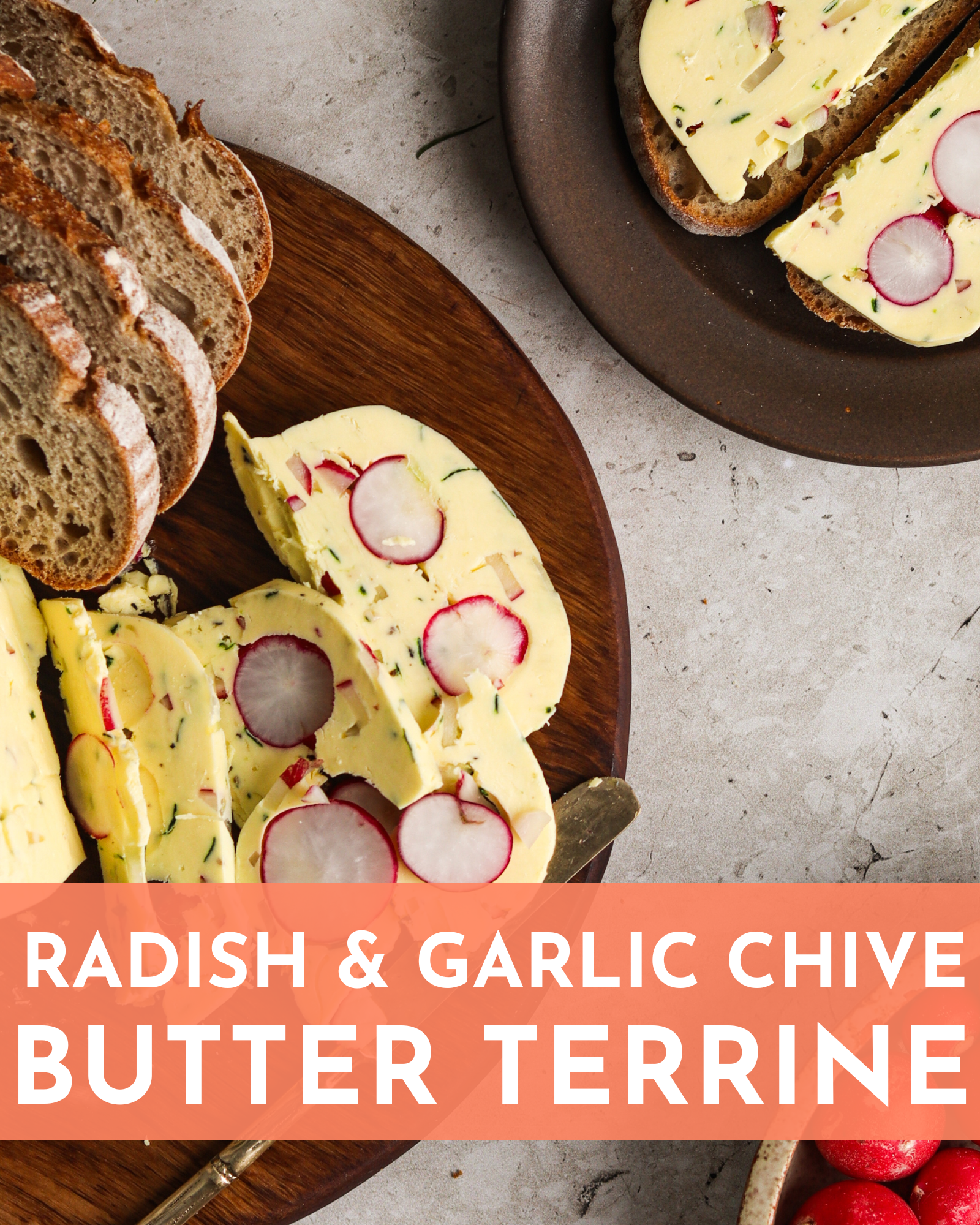
Wish everyone all the best for the New Year. Enjoy reading about other Traditions
Happy and Blessed New Year
In Germany we bake our Christmas Stollen, a bread full of dried fruit soaked in Rum. You need to taste at least seven different breads to have good luuck in the following year. I won’t reach that goal living in Canada’ but I delivered breads among my neighbours